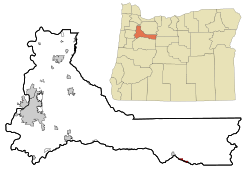Idanha, Oregon facts for kids
Quick facts for kids
Idanha, Oregon
|
|
|---|---|

Idanha City Hall
|
|

Location in Oregon
|
|
| Country | United States |
| State | Oregon |
| Counties | Marion, Linn |
| Incorporated | 1949 |
| Area | |
| • Total | 0.77 sq mi (2.00 km2) |
| • Land | 0.74 sq mi (1.92 km2) |
| • Water | 0.03 sq mi (0.08 km2) |
| Elevation | 1,686 ft (514 m) |
| Population
(2020)
|
|
| • Total | 156 |
| • Density | 210.81/sq mi (81.44/km2) |
| Time zone | UTC-8 (Pacific) |
| • Summer (DST) | UTC-7 (Pacific) |
| ZIP code |
97350
|
| Area code(s) | 503 |
| FIPS code | 41-35800 |
| GNIS feature ID | 2410094 |
Idanha /ɪˈdænə/ is a city on the Marion County/Linn County line in Oregon, United States, on Oregon Route 22 and the Santiam River. The population was 156 at the 2020 census.
The Marion County portion of Idanha is part of the Salem Metropolitan Statistical Area, while the Linn County portion is part of the Albany–Lebanon Micropolitan Statistical Area.
Geography
According to the United States Census Bureau, the city has a total area of 1.09 square miles (2.82 km2), of which 1.06 square miles (2.75 km2) is land and 0.03 square miles (0.08 km2) is water.
Idanha encompasses the area of New Idanha in Linn County, which the USGS classifies as a separate populated place.
Climate
This region experiences warm and dry summers, with no average monthly temperatures above 71.6 °F (22.0 °C). According to the Köppen Climate Classification system, Idanha has a warm-summer Mediterranean climate, abbreviated Csb on climate maps.
Demographics
| Historical population | |||
|---|---|---|---|
| Census | Pop. | %± | |
| 1950 | 442 | — | |
| 1960 | 295 | −33.3% | |
| 1970 | 382 | 29.5% | |
| 1980 | 319 | −16.5% | |
| 1990 | 289 | −9.4% | |
| 2000 | 232 | −19.7% | |
| 2010 | 134 | −42.2% | |
| 2020 | 156 | 16.4% | |
| U.S. Decennial Census | |||
2010 census
As of the census of 2010, there were 134 people, 65 households, and 34 families living in the city. The population density was 126.4 inhabitants per square mile (48.8/km2). There were 86 housing units at an average density of 81.1 per square mile (31.3/km2). The racial makeup of the city was 96.3% White and 3.7% from two or more races. Hispanic or Latino of any race were 5.2% of the population.
There were 65 households, of which 12.3% had children under the age of 18 living with them, 46.2% were married couples living together, 1.5% had a female householder with no husband present, 4.6% had a male householder with no wife present, and 47.7% were non-families. 36.9% of all households were made up of individuals, and 12.3% had someone living alone who was 65 years of age or older. The average household size was 2.06 and the average family size was 2.62.
The median age in the city was 51.2 years. 11.2% of residents were under the age of 18; 5.8% were between the ages of 18 and 24; 12.6% were from 25 to 44; 52.2% were from 45 to 64; and 17.9% were 65 years of age or older. The gender makeup of the city was 56.7% male and 43.3% female.
Education
Idanha is served by the Santiam Canyon School District.
Transportation
Idanha served as the eastern terminus of a transcontinental railroad, proposed by Colonel T. Egenton Hogg, that terminated in Idanha because of a lack of funding. Idanha saw rail service until the 1950s, when the track was removed for development of Detroit Lake, situated over the historical roadbed of the former Oregon Pacific Railroad.
Santiam Fire
Idanha was one of the small cities in the Santiam Canyon impacted by a group of wildfires which converged and were later known collectively as the Santiam Fire. The Lionshead Wildfire had ignited on August 16, 2020, within the nearby Willamette National Forest. It continued burning in the wilderness area with limited intervention by firefighters due to the difficult terrain, slowly growing in size until September 7, 2020, when strong east winds reaching 50 miles per hour (80 km/h) drove the wildfire east through the canyon in which the town of Idanha and several others are located. Chaotic evacuations were ordered during the night of September 7–8, 2020. The Idanha-Detroit Rural Fire Protection District, which serves the cities of Idanha and Detroit, was pivotal in notifying sleeping residents of the evacuations and attempting to manage numerous small fires which had sprung up due to electrical lines coming down in the strong wind, with limited success. Unfortunately the city of Detroit was almost entirely destroyed, and the fire department itself suffered the loss of their administrative office and two fire trucks. Over the coming days, the wildfire would converge with several others in the area and become known as the Santiam Wildfire, destroying 402,274 acres (162,795 ha), among the worst in Oregon's history.
See also
 In Spanish: Idanha para niños
In Spanish: Idanha para niños

